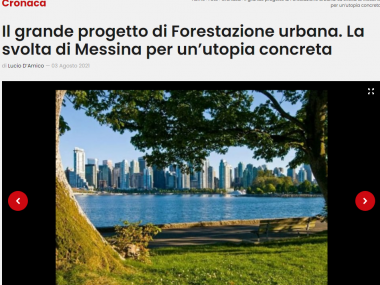Messina becoming a "garden city" - the ForestaME project
Edited on
06 October 2021Urban forestry is today at the top of the agendas of the great cities of the planet and Messina is a candidate to become one of the protagonist cities of a great campaign to reverse climate change in the world.

For this reason ForestaMe, a more than 15 ml projects that formally started last week, represents the green commitment undertaken by the city aimed at achieving the European Green Deal objectives: the largest urban forestry project through which, by reducing CO2 emissions in the urban center and urban centers of the Metropolitan City, it will increase the level of naturalness and urban quality by increasing the resilience of the urban territory to environmental stresses, hydrogeological instability and the effects of climate change and its ability to absorb and compensate for anthropogenic and natural pressures from outside, including the effects of changes climatic.
The main objective is to increase the arboreal and floral heritage of the city and its resilience by increasing biodiversity both in the choice of the type of plants to be introduced into the urban green areas and in a newer perspective and landscape vision of the green connectors. A strategic plan to increase green areas, investing more resources in the redevelopment of greenery, in planting trees and flowers and above all in the tree renewal plan, as a tool to combat climate change.
A green strategy that introduces the psychophysical well-being as a major part of human living and is part of the pilot project Urbact Health and Green Space funded within the URBACT programme in order to increase the beneficial effects of "green" on human health.

The main objective is to increase the arboreal and floral heritage of the city and its resilience by increasing biodiversity both in the choice of the type of plants to be introduced into the urban areas and landscape vision of the green connectors.
A strategic plan to increase green areas, investing more resources in the redevelopment of greenery, in planting trees and flowers and above all in the tree renewal plan, as a tool to combat climate change and at the same time make more effective actions to prevent and fight fires through specific forestry-crop management and better management of fast-growingplantations.
In the design and construction of new forested areas, not only the starting conditions will be considered, but also the function that the new area will have to fulfill.
Re-evaluating a park or a green area without a well-defined purpose, produces only ecological and climatic benefits but does not affect the well-being of citizens or their health.
Parks created with a specific design and purpose have an extremely significant impact on citizens: convalescents recover sooner because the immune system becomes stronger; children grow up more harmoniously and improve school performance; the elderly live better and longer; citizens are inclined to exercise more; pregnant women have less complicated pregnancies; the isolation of people living alone decreases, diseases related to depression and diseases related to stress drastically decrease.
In addition, the busiest and most illuminated parks make the neighborhood more livable and safe and the citizens more serene, urban green spaces produce an extremely positive impact on social cohesion and green areas and shaded areas favor biodiversity and have a tangible beneficial impact on climate.
Written by Josephine di Pino, communication officer of Messina Health&Greenspace team
 Submitted by Viktoria Soos on
Submitted by Viktoria Soos on
